Experimental Study of Direct Shear Properties of Anisotropic Reservoir Shale
Abstract
:1. Introduction
2. Materials and Methods
2.1. Specimen Preparation
2.2. Test Apparatus and Procedure
3. Results
3.1. Relationship between Shear Stress and Shear Displacement
3.2. Shear Failure Pattern
3.3. Shear Fracture Surface Morphology
3.4. Shear Strength and Shear Stiffness
4. Discussion
4.1. Shear Deformation and Failure Characteristics
4.2. Shear Fracture Mode
4.3. Influence of the Bedding Angle
4.4. Influence of the Shear-Strain Rate
4.5. Potential Applications
4.6. Limitations and Prospects
5. Conclusions
- (1)
- The deformation and failure characteristics of shale are affected by the shear mode, shear strain rate, and normal stress. The peak shear displacement, peak shear strength, and shear stiffness of shale fluctuate with an increase in the bedding angle. The peak shear strength of shale decreases with an increase in the shear strain rate, and this tendency decreases with an increase in the shear strain rate.
- (2)
- The shape of the shear fracture zone and the shear fracture mode of shale have clear bedding effect characteristics. With an increase in the bedding angle, the shape of the shear fracture zone changes from a straight rough type to a curved rough type and the influence range of the shear fracture zone expands.
- (3)
- The fractal dimension of the shale shear fracture surface morphology fluctuates with a change in the bedding angle, and the bedding effect of the difference in the local fracture degree and the morphology complexity between the upper and lower shear fracture surfaces increases with an increase in the bedding angle. The larger the shear strain rate, the stronger the bedding effect of the roughness of the shear fracture surface morphology.
Author Contributions
Funding
Data Availability Statement
Acknowledgments
Conflicts of Interest
References
- Zhang, D.; Yang, T.; Wu, T.; Li, X.; Zhao, J. Recovery mechanisms and key issues in shale gas development. Chin. Sci. Bull. 2017, 61, 62–71. (In Chinese) [Google Scholar] [CrossRef]
- Fu, H.J.; Yan, D.T.; Yao, C.P.; Su, X.B.; Wang, X.M.; Wang, H.; Li, Y.G. Pore structure and multi-scale fractal characteristics of adsorbed pores in marine shale: A case study of the Lower Silurian Longmaxi Shale in the Sichuan Basin, China. J. Earth Sci.-China 2022, 33, 1278–1290. [Google Scholar] [CrossRef]
- Curtis, J.B. Fractured shale-gas systems. Am. Assoc. Pet. Geol. Bull. 2002, 86, 1921–1938. [Google Scholar] [CrossRef]
- Martineau, D.F. History of the Newark East field and the Barnett Shale as a gas reservoir. Am. Assoc. Pet. Geol. Bull. 2007, 91, 399–403. [Google Scholar] [CrossRef]
- Yao, J.; Ding, Y.; Sun, H.; Fan, D.; Wang, M.; Jia, C. Productivity analysis of fractured horizontal wells in tight gas reservoirs using a gas-water two-phase flow model with consideration of a threshold pressure gradient. Energy Fuel 2023, 37, 8190–8198. [Google Scholar] [CrossRef]
- Barton, N. Review of a new shear-strength criterion for rock joints. Eng. Geol. 1973, 7, 287–332. [Google Scholar] [CrossRef]
- Grasselli, G.; Egger, P. Constitutive law for the shear strength of rock joints based on three-dimensional surface parameters. Int. J. Rock Mech. Min. Sci. 2003, 40, 25–40. [Google Scholar] [CrossRef]
- Hoek, E. Strength of jointed rock masses. Géotechnique 1983, 33, 187–223. [Google Scholar] [CrossRef]
- Kulatilake, P.H.S.W.; Shou, G.; Huang, T.H.; Morgan, R.M. New peak shear strength criteria for anisotropic rock joints. Int. J. Rock Mech. Min. Sci. Geomech. Abstr. Pergamon 1995, 32, 673–697. [Google Scholar] [CrossRef]
- Li, J.; Li, H.; Zhao, J. An improved equivalent viscoelastic medium method for wave propagation across layered rock masses. Int. J. Rock Mech. Min. Sci. 2015, 73, 62–69. [Google Scholar] [CrossRef]
- Li, J.; Ma, G.; Zhao, J. An equivalent viscoelastic model for rock mass with parallel joints. J. Geophys. Res. Solid. Earth 2010, 115, 1923–1941. [Google Scholar] [CrossRef]
- Li, J.; Rong, L.; Li, H.; Hong, S. An SHPB test study on stress wave energy attenuation in jointed rock masses. Rock Mech. Rock Eng. 2019, 52, 403–420. [Google Scholar] [CrossRef]
- Niandou, H.; Shao, J.; Henry, J.P.; Fourmaintraux, D. Laboratory investigation of the mechanical behaviour of Tournemire shale. Int. J. Rock Mech. Min. Sci. 1997, 34, 3–16. [Google Scholar] [CrossRef]
- Zheng, B.; Qi, S.; Luo, G.; Liu, F.; Huang, X.; Guo, S. Characterization of discontinuity surface morphology based on 3D fractal dimension by integrating laser scanning with ArcGIS. Bull. Eng. Geol. Environ. 2021, 80, 2261–2281. [Google Scholar] [CrossRef]
- Zhao, Y.; Borja, R.I. A double-yield-surface plasticity theory for transversely isotropic rocks. Acta Geotech. 2022, 17, 5201–5221. [Google Scholar] [CrossRef]
- Zhao, Y.; Wang, R.; Zhang, J. A dual-mechanism tensile failure criterion for transversely isotropic rocks. Acta Geotech. 2022, 17, 5187–5200. [Google Scholar] [CrossRef]
- He, J.; Afolagboye, L.O. Influence of layer orientation and interlayer bonding force on the mechanical behavior of shale under Brazilian test conditions. Acta Mech. Sin. 2018, 34, 349–358. [Google Scholar] [CrossRef]
- Josh, M.; Esteban, L.; Piane, C.D.; Sarout, J.; Dewhurst, D.N.; Clennell, M.B. Laboratory characterisation of shale properties. J. Pet. Sci. Eng. 2012, 88–89, 107–124. [Google Scholar] [CrossRef]
- Kuila, U.; Dewhurst, D.N.; Siggins, A.F.; Raven, M.D. Stress anisotropy and velocity anisotropy in low porosity shale. Tectonophysics 2011, 503, 34–44. [Google Scholar] [CrossRef]
- Lu, H.; Xie, H.; Luo, Y.; Ren, L.; Zhang, R.; Li, C.; Wang, J.; Yang, M. Failure characterization of Longmaxi shale under direct shear mode loadings. Int. J. Rock Mech. Min. Sci. 2021, 148, 104936. [Google Scholar] [CrossRef]
- Ma, T.; Chen, P. Prediction method of shear instability region around the borehole for horizontal wells in bedding shale. Pet. Drill. Tech. 2014, 42, 26–36. (In Chinese) [Google Scholar] [CrossRef]
- Heng, S.; Guo, Y.; Yang, C.; Daemen, J.J.K.; Li, Z. Experimental and theoretical study of the anisotropic properties of shale. Int. J. Rock Mech. Min. Sci. 2015, 74, 58–68. [Google Scholar] [CrossRef]
- Daneshy, A.A. Off-balance growth: A new concept in hydraulic fracturing. J. Pet. Technol. 2003, 55, 78–85. [Google Scholar] [CrossRef]
- Heng, S.; Li, X.; Liu, X.; Zhang, X. Study on the propagation mechanisms of shale fractures under direct shear conditions. Chin. J. Rock Mech. Eng. 2019, 38, 2438–2450. (In Chinese) [Google Scholar] [CrossRef]
- Barton, N.; Bandis, S.; Bakhtar, K. Strength, deformation and conductivity coupling of rock joints. Int. J. Rock Mech. Min. Sci. Geomech. Abstr. 1985, 22, 121–140. [Google Scholar] [CrossRef]
- Barton, N.; Choubey, V. The shear strength of rock joints in theory and practice. Rock Mech. 1977, 10, 1–54. [Google Scholar] [CrossRef]
- Homand, F.; Belem, T.; Souley, M. Friction and degradation of rock joint surfaces under shear loads. Int. J. Numer. Anal. Methods Geomech. 2001, 25, 973–999. [Google Scholar] [CrossRef]
- Jing, L.; Nordlund, E.; Stephansson, O. An experimental study on the anisotropy and stress-dependency of the strength and deformability of rock joints. Int. J. Rock Mech. Min. Sci. Geomech. Abstr. 1992, 29, 535–542. [Google Scholar] [CrossRef]
- Li, J.; Yuan, W.; Li, H.; Zou, C. Study on dynamic shear deformation behaviors and test methodology of sawtooth-shaped rock joints under impact load. Int. J. Rock Mech. Min. Sci. 2022, 158, 105210. [Google Scholar] [CrossRef]
- Luo, G.; Qi, S.; Zheng, B. Rate effect on the direct shear behavior of granite rock bridges at low to subseismic shear rates. J. Geophys. Res. Solid Earth 2022, 127, e2022JB024348. [Google Scholar] [CrossRef]
- Yu, K.W.; Xu, L.; Peng, J.B.; Zuo, L.; Guan, G.X. Development of a new in-situ interface shear box test apparatus and its applications. J. Earth Sci.-China 2023, 34, 935–939. [Google Scholar] [CrossRef]
- Yuan, H.; Chen, P. Strength weakening rules of shale hydration based on direct shear tests. Nat. Gas. Ind. 2015, 35, 71–77. (In Chinese) [Google Scholar] [CrossRef]
- Li, T. Study on Anisotropic Mechanical Behavior of Reservoir Shale in Shear Failure. Master’s Thesis, Chongqing University, Chongqing, China, 2021. (In Chinese) [Google Scholar] [CrossRef]
- Qi, S.; Zheng, B.; Wu, F.; Huang, X.; Guo, S.; Zhan, Z.; Zou, Y.; Barla, G. A new dynamic direct shear testing device on rock joints. Rock Mech. Rock Eng. 2020, 53, 4787–4798. [Google Scholar] [CrossRef]
- Martin, C.D.; Chandler, N.A. The progressive fracture of Lac du Bonnet granite. Int. J. Rock Mech. Min. Sci. Geomech. Abstr. 1994, 31, 643–659. [Google Scholar] [CrossRef]
- Asadizadeh, M.; Moosavi, M.; Hossaini, M.F.; Masoumi, H. Shear strength and cracking process of non-persistent jointed rocks: An extensive experimental investigation. Rock Mech. Rock Eng. 2018, 51, 415–428. [Google Scholar] [CrossRef]
- Cui, Y. Effect of joint type on the shear behavior of synthetic rock. Bull. Eng. Geol. Environ. 2019, 78, 3395–3412. [Google Scholar] [CrossRef]
- Lajtai, E.Z. Shear strength of weakness planes in rock. Int. J. Rock Mech. Min. Sci. Geomech. Abstr. 1969, 6, 499–515. [Google Scholar] [CrossRef]
- Lajtai, E.Z. Strength of discontinuous rocks in direct shear. Géotechnique 1969, 19, 218–233. [Google Scholar] [CrossRef]
- Ikari, M.J.; Niemeijer, A.R.; Marone, C. Experimental investigation of incipient shear failure in foliated rock. J. Struct. Geol. 2015, 77, 82–91. [Google Scholar] [CrossRef]
- Buocz, I.; Rozgonyi-Boissinot, N.; Török, Á. Influence of discontinuity inclination on the shear strength of Mont Terri Opalinus Claystones. Period. Polytech.-Civ. 2017, 61, 447–453. [Google Scholar] [CrossRef]
- Crawford, A.M.; Curran, J.H. The influence of shear velocity on the frictional resistance of rock discontinuities. Int. J. Rock Mech. Min. Sci. Geomech. Abstr. 1981, 18, 505–515. [Google Scholar] [CrossRef]
- Atapour, H.; Moosavi, M. The influence of shearing velocity on shear behavior of artificial joints. Rock Mech. Rock Eng. 2014, 47, 1745–1761. [Google Scholar] [CrossRef]
- Zheng, B.; Qi, S.; Huang, X.; Guo, S.; Wang, C.; Zhan, Z.; Luo, G. An advanced shear strength criterion for rock discontinuities considering size and low shear rate. Appl. Sci. 2020, 10, 4095. [Google Scholar] [CrossRef]
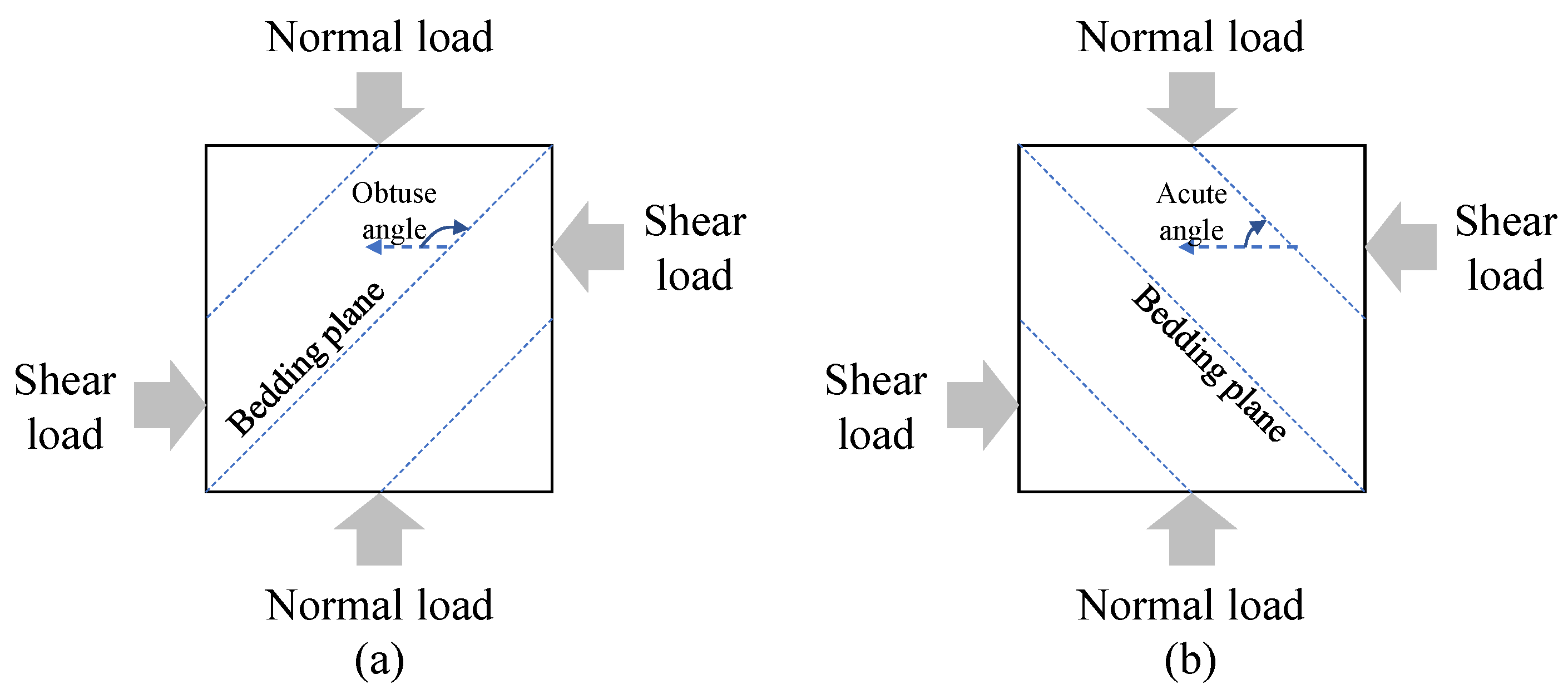
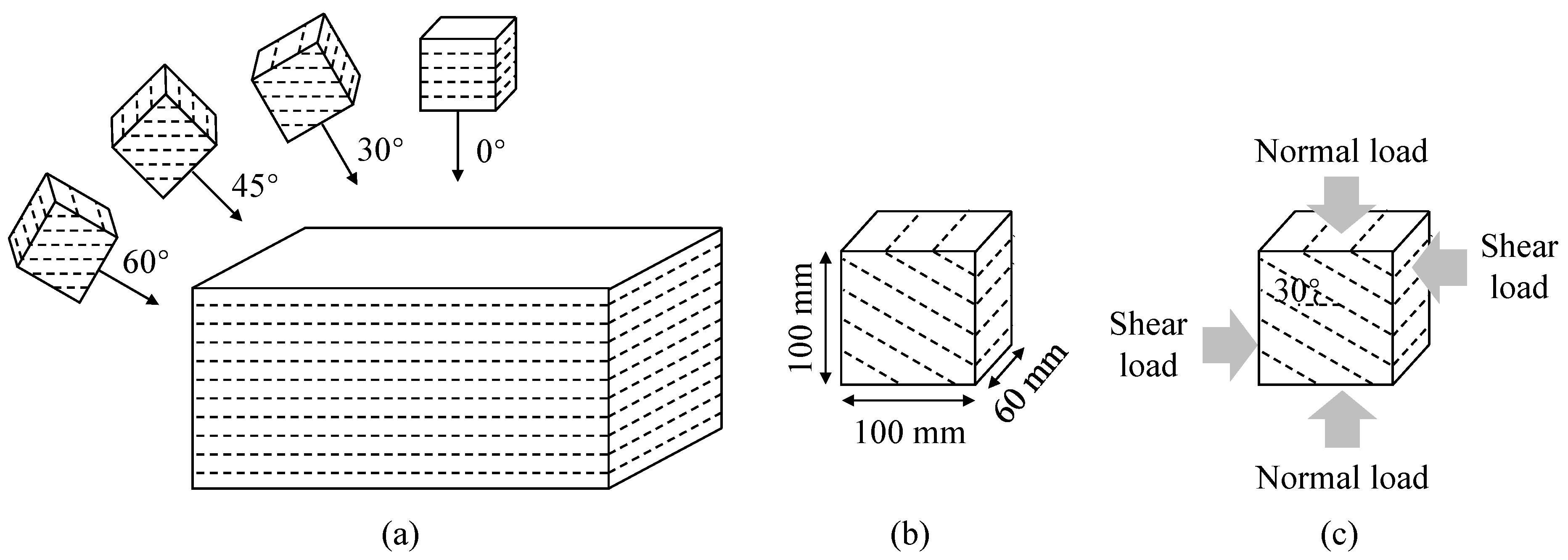


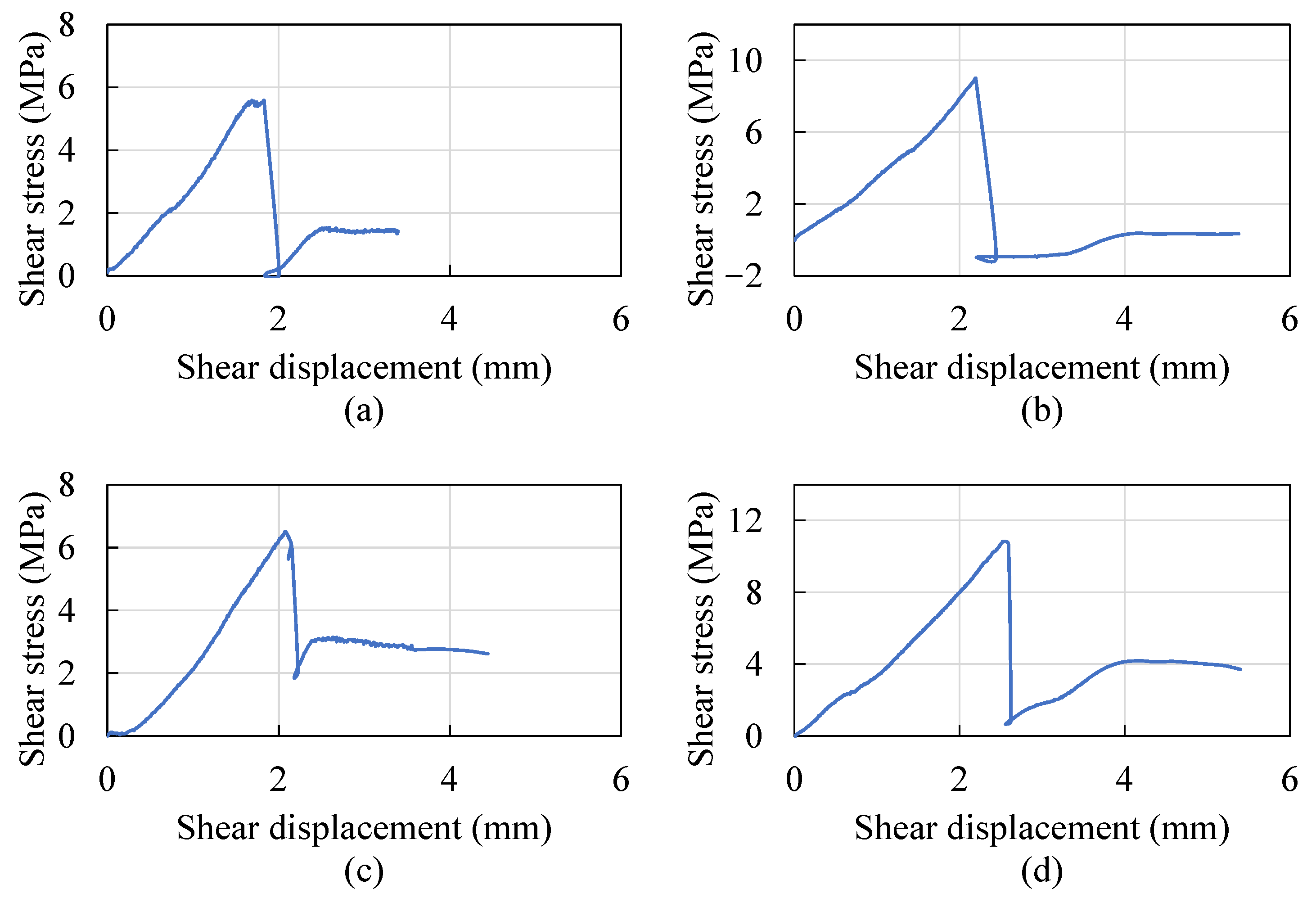
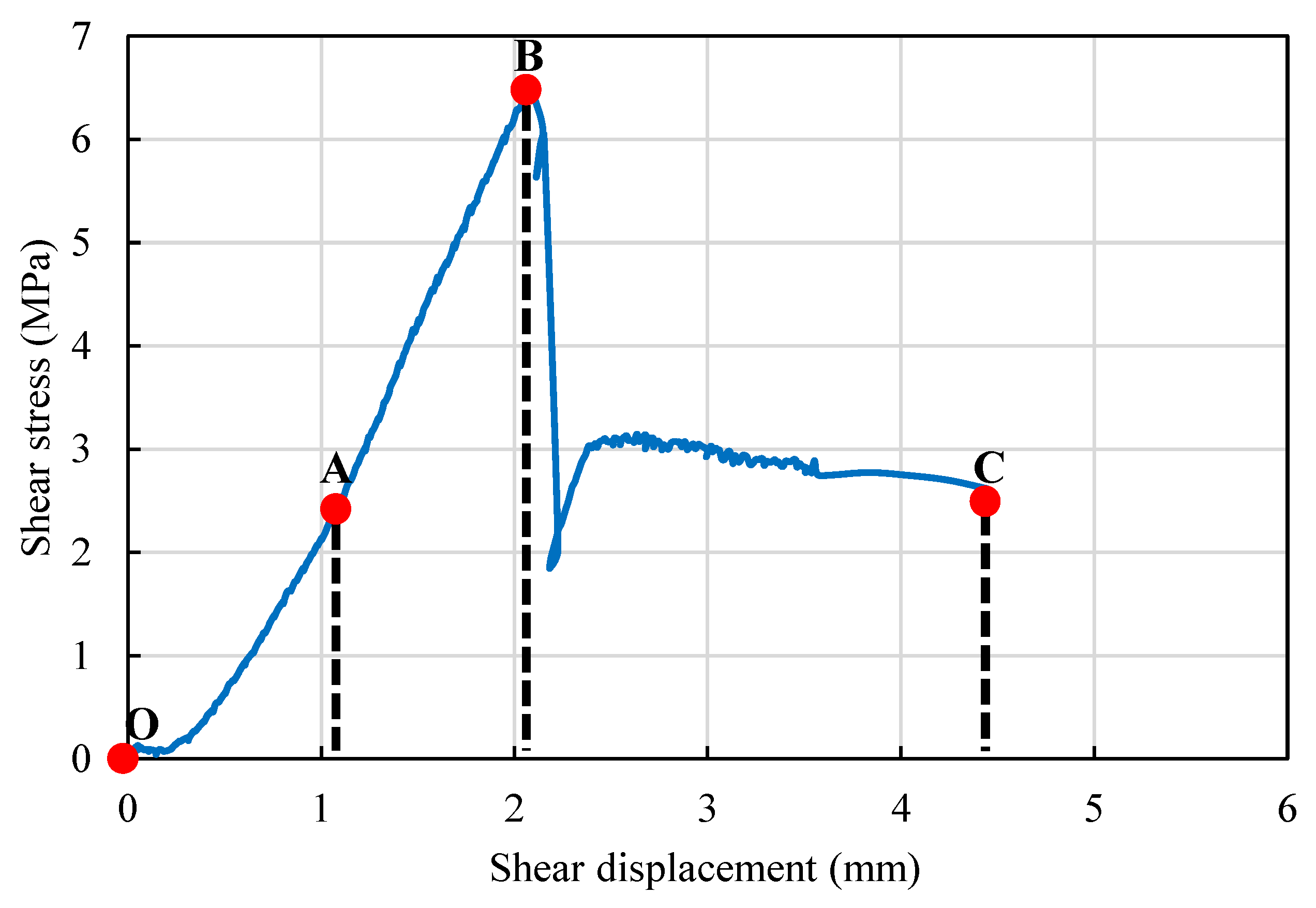

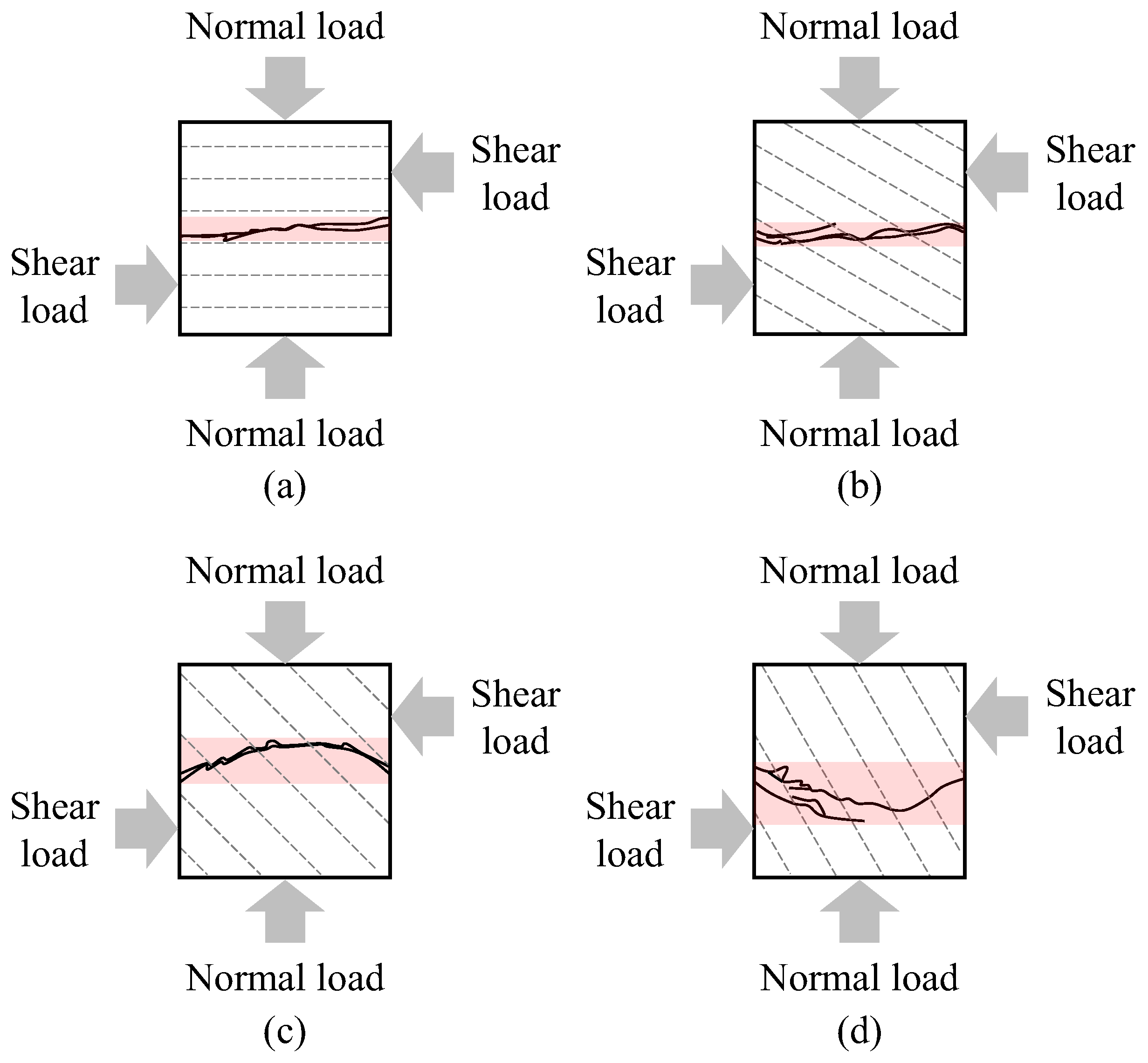
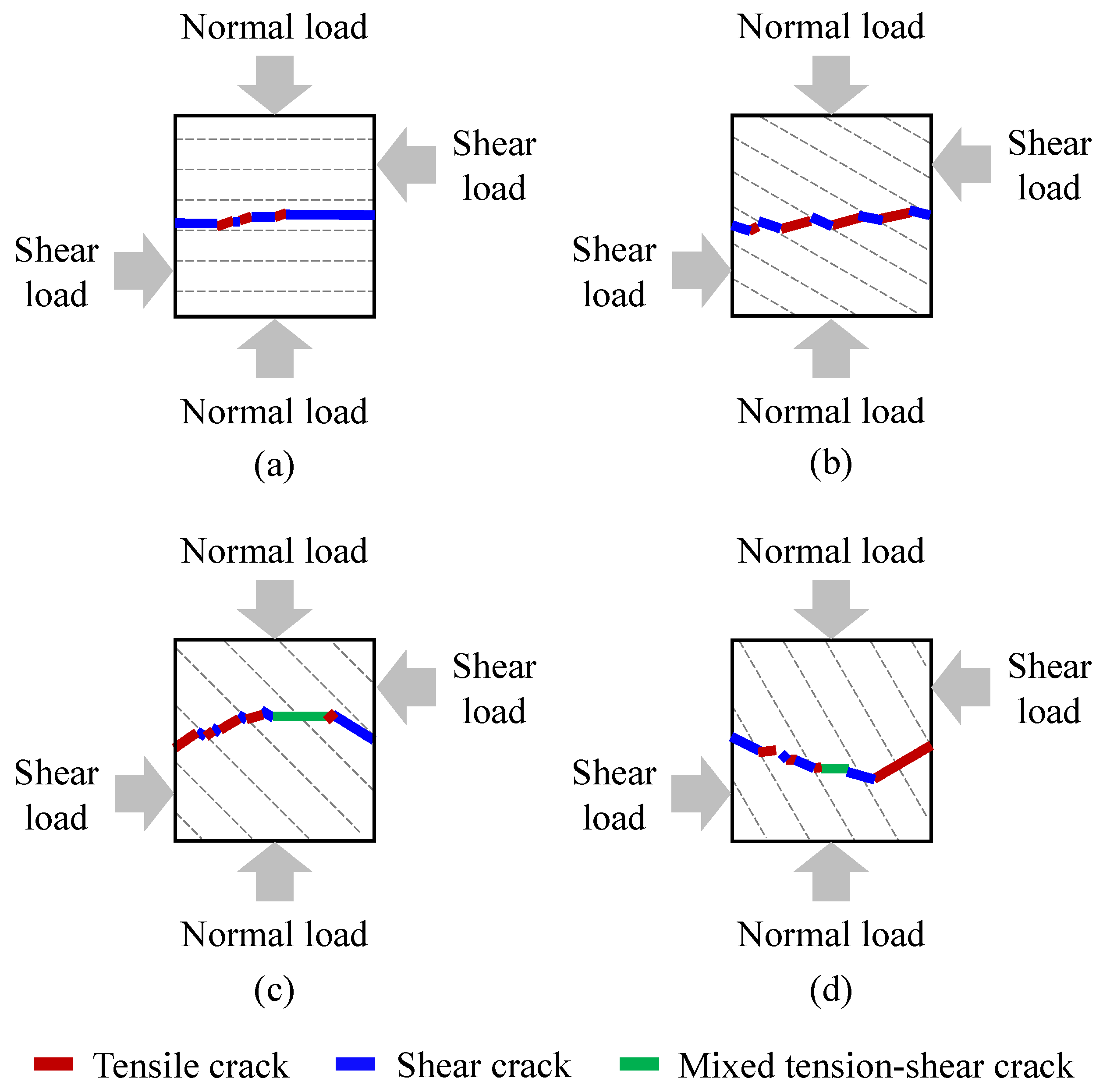
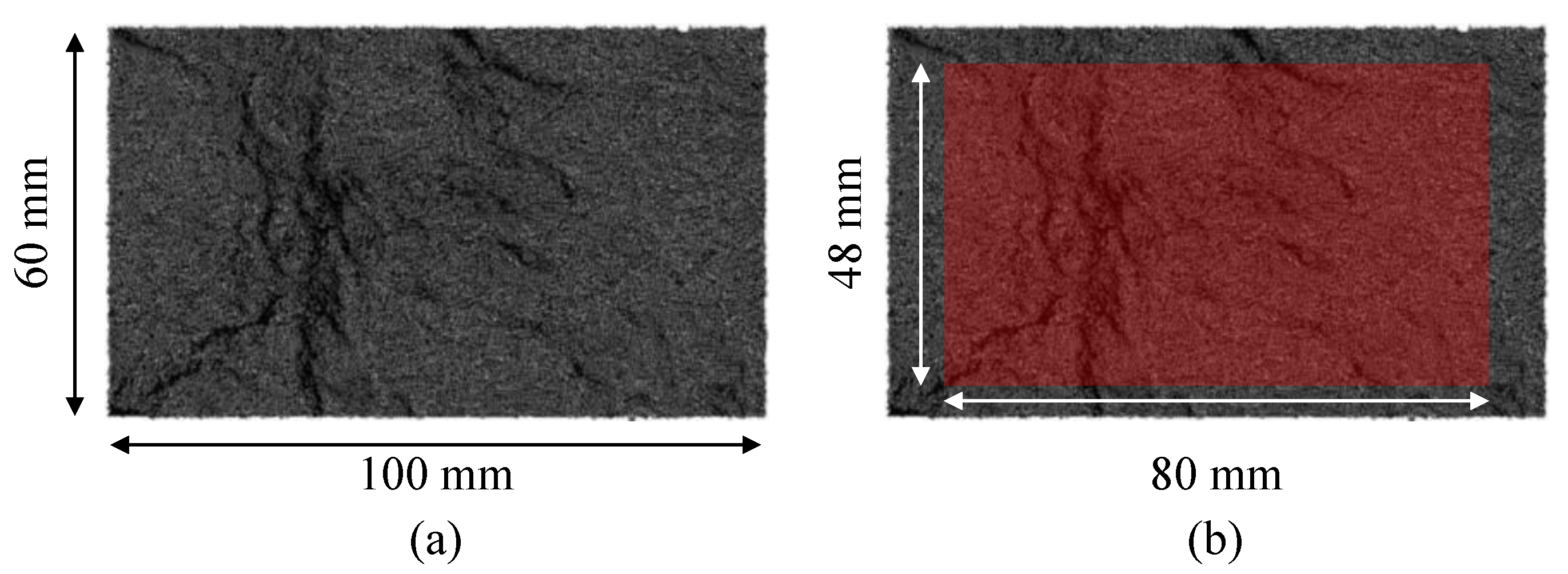



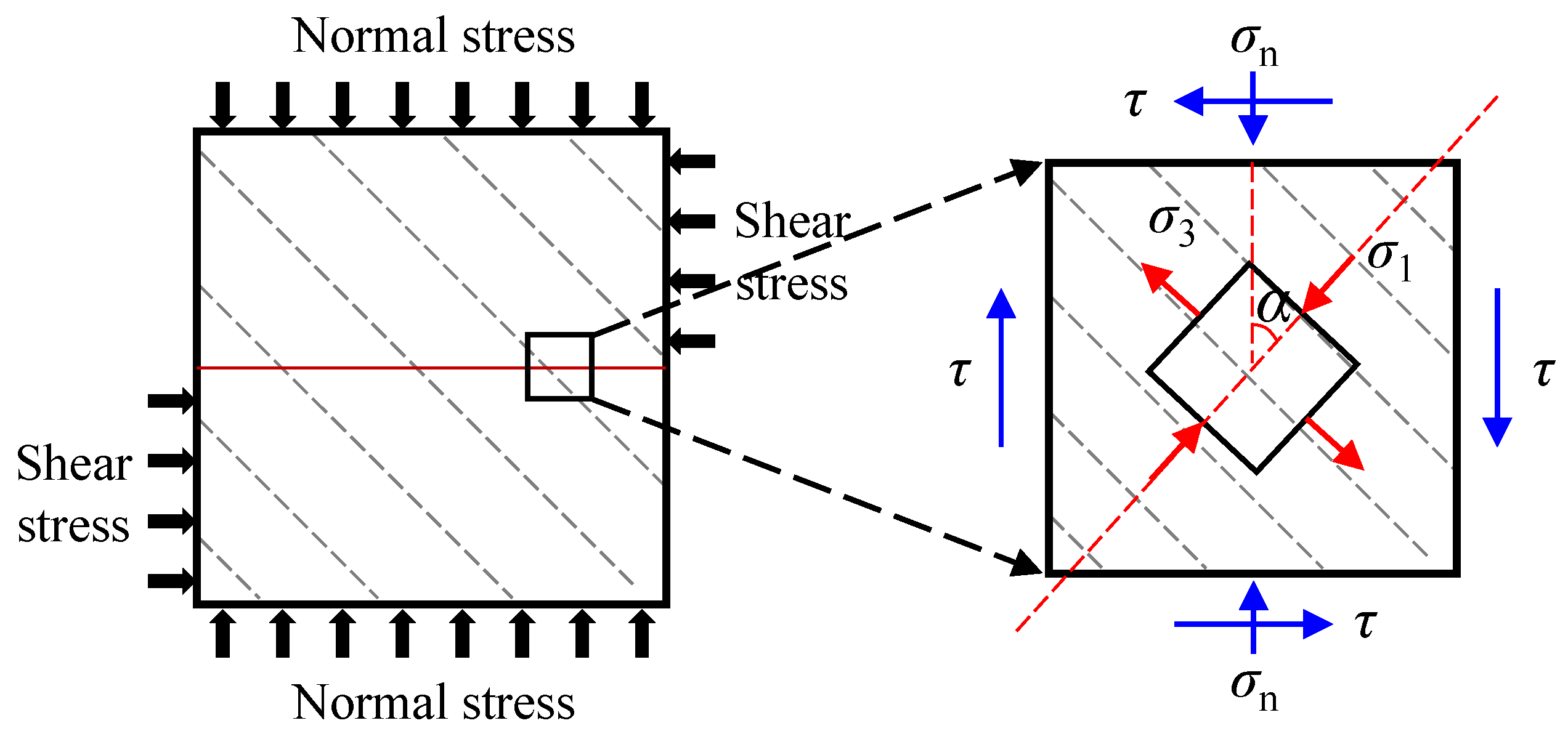




| Bedding Angle (°) | Normal Loading Condition | Normal Loading Rate (N/s) | Normal Stress (MPa) | Shear Loading Condition | Shear Loading Rate (mm/s) | Shear Strain Rate (/s) |
|---|---|---|---|---|---|---|
| 0, 30, 45, 60 | Constant normal load (CNL) | 50 | 1 | Constant shear rate (CSR) | 0.01 | 0.0001 |
| Bedding Angle (°) | Peak Shear Strength Formula | Normal Stress (MPa) | Calculated Peak Shear Strength (MPa) | Reference |
|---|---|---|---|---|
| 0 | τp = 0.648·σn + 19.488 | 1 | 20.136 | [20] |
| 30 | τp = 0.723·σn + 22.896 | 23.619 | ||
| 60 | τp = 0.595·σn + 31.165 | 31.760 | ||
| 90 | τp = 0.512·σn + 31.151 | 31.663 | ||
| 0 | τp = σn·tan (22.538°) + 12.114 | 12.529 | [33] | |
| 30 | τp = σn·tan (20.606°) + 12.820 | 13.196 | ||
| 45 | τp = σn·tan (26.565°) + 10.489 | 10.989 | ||
| 60 | τp = σn·tan (22.782°) + 17.393 | 17.813 |
| Sample Shape/ Sample Size (mm) | Shear Rate (mm/s)/ Shear Strain Rate (/s) | Normal Stress (MPa) | Bedding Angle (°) | Reference | |||
|---|---|---|---|---|---|---|---|
| 0 | 30 | 45 | 60 | ||||
| Peak Shear Strength (MPa) | |||||||
| Cubic/ Length: 50 | 0.0003/ 6 × 10−6 | 1 | 20.14 | 23.62 | -- | 31.76 | [20] |
| Cylinder/ Diameter: 50 | 0.002/ 4 × 10−5 | 12.53 | 13.20 | 10.99 | 17.81 | [33] | |
| Cubic/ Length: 100 | 0.01/ 1 × 10−4 | 5.59 | 9.01 | 6.51 | 10.83 | This paper | |
Disclaimer/Publisher’s Note: The statements, opinions and data contained in all publications are solely those of the individual author(s) and contributor(s) and not of MDPI and/or the editor(s). MDPI and/or the editor(s) disclaim responsibility for any injury to people or property resulting from any ideas, methods, instructions or products referred to in the content. |
© 2024 by the authors. Licensee MDPI, Basel, Switzerland. This article is an open access article distributed under the terms and conditions of the Creative Commons Attribution (CC BY) license (https://creativecommons.org/licenses/by/4.0/).
Share and Cite
Zheng, B.; Qi, S.; Guo, S.; Liang, N.; Luo, G.; Zhang, X.; Lu, W.; Jin, C.; Li, Y.; Yu, X.; et al. Experimental Study of Direct Shear Properties of Anisotropic Reservoir Shale. Energies 2024, 17, 1977. https://doi.org/10.3390/en17081977
Zheng B, Qi S, Guo S, Liang N, Luo G, Zhang X, Lu W, Jin C, Li Y, Yu X, et al. Experimental Study of Direct Shear Properties of Anisotropic Reservoir Shale. Energies. 2024; 17(8):1977. https://doi.org/10.3390/en17081977
Chicago/Turabian StyleZheng, Bowen, Shengwen Qi, Songfeng Guo, Ning Liang, Guangming Luo, Xiaohui Zhang, Wei Lu, Chao Jin, Yongchao Li, Xin Yu, and et al. 2024. "Experimental Study of Direct Shear Properties of Anisotropic Reservoir Shale" Energies 17, no. 8: 1977. https://doi.org/10.3390/en17081977





